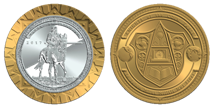Between 1973 and 1981 I was responsable for getting moulds for labo test machines ; the first mould cracked in two pieces during the deep hardening process in Holland .
So I went to high Brinell hardness materials and sputter cutting and only surface hardening . Solved that problem . Not the flow problems though since in those years the computer flow predictions of plastic matter were not very good . It was mostly trial and error and getting a robot to do 24 hours of polishing with diamond paste

to get the mirror finish ( deep ultra cameo

The making of a die or mould can be the same . A die however stamps . A mould only has to remain closed with a few hundred tons of closing pressure . Allthough it is easy to make a fake coin by having a mould in dental plastic and clamping it between a vice to "strike" the coin
Will break though after only a few coins


